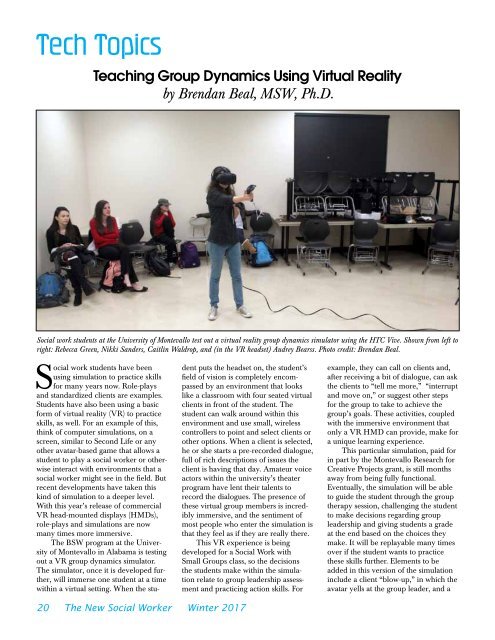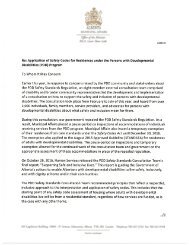In This Issue
click
click
Create successful ePaper yourself
Turn your PDF publications into a flip-book with our unique Google optimized e-Paper software.
Tech Topics<br />
Teaching Group Dynamics Using Virtual Reality<br />
by Brendan Beal, MSW, Ph.D.<br />
Social work students at the University of Montevallo test out a virtual reality group dynamics simulator using the HTC Vive. Shown from left to<br />
right: Rebecca Green, Nikki Sanders, Caitlin Waldrop, and (in the VR headset) Audrey Bearss. Photo credit: Brendan Beal.<br />
Social work students have been<br />
using simulation to practice skills<br />
for many years now. Role-plays<br />
and standardized clients are examples.<br />
Students have also been using a basic<br />
form of virtual reality (VR) to practice<br />
skills, as well. For an example of this,<br />
think of computer simulations, on a<br />
screen, similar to Second Life or any<br />
other avatar-based game that allows a<br />
student to play a social worker or otherwise<br />
interact with environments that a<br />
social worker might see in the field. But<br />
recent developments have taken this<br />
kind of simulation to a deeper level.<br />
With this year’s release of commercial<br />
VR head-mounted displays (HMDs),<br />
role-plays and simulations are now<br />
many times more immersive.<br />
The BSW program at the University<br />
of Montevallo in Alabama is testing<br />
out a VR group dynamics simulator.<br />
The simulator, once it is developed further,<br />
will immerse one student at a time<br />
within a virtual setting. When the student<br />
puts the headset on, the student’s<br />
field of vision is completely encompassed<br />
by an environment that looks<br />
like a classroom with four seated virtual<br />
clients in front of the student. The<br />
student can walk around within this<br />
environment and use small, wireless<br />
controllers to point and select clients or<br />
other options. When a client is selected,<br />
he or she starts a pre-recorded dialogue,<br />
full of rich descriptions of issues the<br />
client is having that day. Amateur voice<br />
actors within the university’s theater<br />
program have lent their talents to<br />
record the dialogues. The presence of<br />
these virtual group members is incredibly<br />
immersive, and the sentiment of<br />
most people who enter the simulation is<br />
that they feel as if they are really there.<br />
<strong>This</strong> VR experience is being<br />
developed for a Social Work with<br />
Small Groups class, so the decisions<br />
the students make within the simulation<br />
relate to group leadership assessment<br />
and practicing action skills. For<br />
example, they can call on clients and,<br />
after receiving a bit of dialogue, can ask<br />
the clients to “tell me more,” “interrupt<br />
and move on,” or suggest other steps<br />
for the group to take to achieve the<br />
group’s goals. These activities, coupled<br />
with the immersive environment that<br />
only a VR HMD can provide, make for<br />
a unique learning experience.<br />
<strong>This</strong> particular simulation, paid for<br />
in part by the Montevallo Research for<br />
Creative Projects grant, is still months<br />
away from being fully functional.<br />
Eventually, the simulation will be able<br />
to guide the student through the group<br />
therapy session, challenging the student<br />
to make decisions regarding group<br />
leadership and giving students a grade<br />
at the end based on the choices they<br />
make. It will be replayable many times<br />
over if the student wants to practice<br />
these skills further. Elements to be<br />
added in this version of the simulation<br />
include a client “blow-up,” in which the<br />
avatar yells at the group leader, and a<br />
20 The New Social Worker Winter 2017




